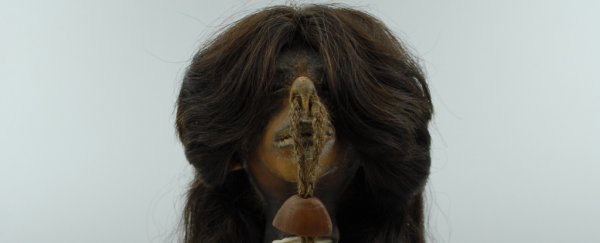Reduced to the size of an apple with their eyes and lips stitched shut, it's easy to forget that these iconic shrunken heads are, in fact, the remains of real humans who once lived and breathed.
For centuries, the famous relics (known as tsantsas) of the indigenous Ecuadorean Shuar people have been sold as novelties, used as props in movies and theater, and placed on display to lure curious crowds.
So blurred is the line between cultural artifact and whimsical tchotchke that it's all but impossible to tell which tsantsa are authentic products of a lost culture and which were fabricated to cash in on our fetish for the strange and the exotic.
Now, thanks to experimental work carried out by researchers from Western University and Object Research Systems in Canada, and University of San Francisco, Quito in Ecuador, anthropologists might, at last, have a tool for distinguishing which are most likely to be fake.
Using different resolutions of X-ray scans to reveal contrasting levels of detail in cuts, anatomy, and stitching, researchers were able to spot key differences that separate ceremonial from commercial tsantsas.
The history of the unusual funerary practice is a murky one, obscured by a lack of written records and conflicting evidence.
Some think it's exclusively the domain of the Shuar, who have called Ecuador and Peru home for centuries. Others think it extends to other cultures that speak one of a number of closely related languages.
Ethnohistorians estimate the action of removing and preserving heads in this way extends back as far as the 16th century, done with the intention of trapping an individual's soul.
Though many thought it was only ever carried out on the Shuar's enemies, such as the Amazonian Achuar people, contemporary Shuar authorities claim it was also performed on respected community leaders.
Without clear records on why or even how the ritual was initially performed, many questions still remain.
That said, there is a broad consensus on the basic steps of a ceremonial tsantsa creation.
Just a small word of warning for the squeamish… you might want to skip the next three paragraphs.
Heads were typically severed at the base of the neck and strung on a vine or thrown into a basket to be taken back for processing. The scalp was split open with a bamboo knife or a sharp stone or shell, with the skull removed and discarded into a nearby river.
The skin was subsequently boiled for up to two hours, killing microbes and causing the flesh to shrink slightly. Then it was a matter of turning the face and scalp inside out, removing as much connective tissue as possible, stitching the eyes shut with fibers from an Astrocaryum chambira palm, and turning the whole thing back the right way again.
Once the mouth was pegged shut with bamboo (or sewn with more fibers) and other incisions stitched, hot rocks were placed inside the head to help further shrink it. Finally, hot sand was poured inside to fill every nook and cranny, drying it out and helping ensure preservation.
(For those who skipped the above three paragraphs, welcome back.)
Unlike what we might see in movies or read in books, tsantas weren't worn – they were instead hung from poles.
We can only imagine the thoughts of explorers and missionaries chancing upon these powerful totems. Yet by the early to mid-19th century, the Shuar and Achuar were trading with nearby European settlers. Among the items to make their way into the hands of collectors around the world were these ceremonial magic vessels.
With growing demand – and high rewards – came the temptation to turn this practice into something more commercial.
Therefore, not only did bona fide human heads find their way onto the market, skins from pigs, monkeys, and sloths were cleverly transformed into something vaguely human.
Identifying the line between something ceremonial and something that could be sold for a profit isn't as easy as analyzing the skin and hair for signs of a human origin, though.
Some accounts suggest even authentic heads had been adorned with hair and other materials from animals. Questionable news reports even suggested unclaimed human bodies from local hospitals provided the materials on occasion.
By landing on a small handful of specifics that can be used to increase the likelihood that a tsantsa in a collection was produced for a ceremonial purpose – the stitching, the anatomy of the ear and the eye, and scalp anatomy – researchers argue it might be possible to fill in missing knowledge on these shrunken heads' origins.
As it is, the authors are confident no clear line exists between purely ceremonial artifacts and those made only for commercial gain.
But there are signs of fakery if you know where to look, in the shape of anatomical features, the length and density of hair fibers, and the folding of the skin – observations that can be made most easily with X-ray CT scans taken at several resolutions.
The team tested their criteria on a tsantsa that had made its way into the collections of the Chatham-Kent Museum in Ontario, Canada, in the 1940s. The artifact appears now to be confirmed as human, though not likely to have been made for ceremonial purposes.
Understanding the history of any individual tsantsa not only gives anthropologists a means of studying the ethnography of South America's indigenous people. It returns a small amount of dignity to a host of human remains that were once bought and sold as mere curios.
This research was published in PLoS One.
